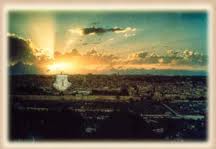“One thing I ask of HaShem, that I seek-that I may dwell in the house of HaShem all the days of my life, to see the pleasantness of HaShem and to visit His Temple every morning.( psalm 27:4)
Shabbat Chazon is the Shabbat that precedes the fast day of Tisha b’Av . This fast ( the 9th of Av) commemorates the destruction of both temples ,in addition to a whole tragic litany of difficult and painful events in Jewish history. On Shabbat Chazon or the “Shabbat of Vision” we read the Haftara portion from the prophecies of Isaiah (1:1-27). This haftara is the final of the “three of readings of affliction,” preceding Tish b’Av and next Shabbat we begin the series of haftara readings called the “Haftarot of Consolation”. The reading begins with the words ” The vision ( Chazon) of Isaiah the son of Amoz, which he saw concerning Judah and Jerusalem, “( Isaiah 1:1) and we feel impelled to explore the word Chazonor Vision in order to discover what light that word may reveal regarding these difficult days. This is especially true as in this week’s Torah portion of Devarim we read of the commandment to “see” several times. It would seem that understanding the themes of vision and lack of vision is critical in these days.
The 9th day of the Jewish month of Av, Tisha b’Av, is a day that exemplifies sadness. It is a time appointed for sad things to possibly occur. In the Hellenistic mindset that has defined most of western thinking for over two thousand years, “Time” is viewed as a linear line moving from point a to point b. the Jewish and Biblical view of the world views specific dates and appointed times are gates through which time flows in a cyclical and upward spiral fashion. Those times affect and spark either spiritual turmoil or yearning and growth.
Tisha B’av is one of those times.
At the borders of the biblical land of Israel Moshe wanted the twelve scouts to explore the land reveal its greatness and bring back tidings of its promise. Ten of these men did not have the vision to do that. All they saw was their own unworthiness, “And there we saw the Nephilim, the sons of Anak, who come of the Nephilim; and we were in our own sight as grasshoppers, and so we were in their sight.” (Numbers 13:33 ). All that they were able to see were their own fears and insecurities;
“ You murmured in your tents and said, ‘”Because the Lord hates us, He took us out of the land of Egypt, to deliver us into the hand[s] of the Amorites to exterminate us.” (Deuteronomy 1:27)
The sages in tractate Taanit ( 29a) state that the children of Israel cried a Bichiya Shel Chinam, a baseless weeping on that night.. HaShem responds by saying, “You cried for nothing, in the future, this day of Tisha B’av ( the ninth day of the month of Av) is appointed for tragedies and real weeping.
What then are we to learn from this? Rav Lior, the Rabbi of Kiryat Arba asked why it was that this “sin of the spies” led to such great tragedies and sorrow. He explains that it was not just that they lost faith in G-d and in themselves. He contemplates what would have happened if they had come back with a good report? What would have happened if the people of Israel would have entered the land of Israel and had built their temple and had implanted the awareness of the Presence of G-d in his land as a permanent fixture. The world would be very different today.
Yet instead their impaired vision of ” we were in our own sight as grasshoppers” weakened them in their journey into destiny. That same impaired vision continues to stymie and hinder many segments in our population and of our leadership to this very day. It continues to keep great portions of our people in exile.
Shabbat Chazon is not only a description of the vision of what went wrong and how unworthy we were. It is more a vision of what we could be and what we truly can achieve in our journey’s mission.
As we read further in the haftara;
” And I will return My hand upon you and purge away your dross as with lye, and remove all your tin. And I will restore your judges as at first and your counselors as in the beginning; afterwards you shall be called City of Righteousness, Faithful City. Zion shall be redeemed through justice and her penitent through righteousness” ( Isaiah 1:25-27).
It is the lack of vision and our impaired ability to truly “see” that keeps blocking us from our goal. Yet it is the rebuilding of the Temple in HaShem’s time that will prove to be the remedy. It is in that place that we would learn to truly see again. Since it is on that mount that the promise of that vision was first established “ And Abraham called the name of that place Adonai-Yireh; as it is said to this day: ‘In the mount where HaShem is seen.'( Genesis 22:14)

